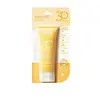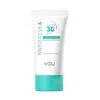What's inside
What's inside
 Key Ingredients
Key Ingredients

 Benefits
Benefits

 Concerns
Concerns

 Ingredients Side-by-side
Ingredients Side-by-side

Water
Skin ConditioningEthylhexyl Methoxycinnamate
UV AbsorberPropylene Glycol
Humectant4-Methylbenzylidene Camphor
UV AbsorberAcrylates Copolymer
Polyacrylamide
Butyl Methoxydibenzoylmethane
UV AbsorberDimethicone
EmollientPanthenol
Skin ConditioningCyclopentasiloxane
EmollientTriethanolamine
BufferingPhenoxyethanol
PreservativeC13-14 Isoparaffin
EmollientAloe Barbadensis Leaf Extract
EmollientLaureth-7
EmulsifyingDimethicone Crosspolymer
Emulsion StabilisingCarbomer
Emulsion StabilisingTocopheryl Acetate
AntioxidantDisodium EDTA
Triethylene Glycol
MaskingDimethicone/Vinyl Dimethicone Crosspolymer
Skin ConditioningDimethiconol
EmollientPotassium Sorbate
PreservativeSodium Benzoate
MaskingWater, Ethylhexyl Methoxycinnamate, Propylene Glycol, 4-Methylbenzylidene Camphor, Acrylates Copolymer, Polyacrylamide, Butyl Methoxydibenzoylmethane, Dimethicone, Panthenol, Cyclopentasiloxane, Triethanolamine, Phenoxyethanol, C13-14 Isoparaffin, Aloe Barbadensis Leaf Extract, Laureth-7, Dimethicone Crosspolymer, Carbomer, Tocopheryl Acetate, Disodium EDTA, Triethylene Glycol, Dimethicone/Vinyl Dimethicone Crosspolymer, Dimethiconol, Potassium Sorbate, Sodium Benzoate
Water
Skin ConditioningEthylhexyl Methoxycinnamate
UV AbsorberPropylene Glycol
HumectantDiethylamino Hydroxybenzoyl Hexyl Benzoate
UV FilterOctocrylene
UV AbsorberDimethicone
EmollientCetearyl Alcohol
EmollientC14-22 Alcohols
Emulsion StabilisingCyclopentasiloxane
EmollientEthylhexyl Triazone
UV AbsorberGlyceryl Stearate
EmollientPhenoxyethanol
PreservativePEG-100 Stearate
Titanium Dioxide
Cosmetic ColorantAmmonium Acryloyldimethyltaurate/Vp Copolymer
C12-20 Alkyl Glucoside
EmulsifyingDimethicone Crosspolymer
Emulsion StabilisingHydroxyacetophenone
AntioxidantCyclohexasiloxane
EmollientSodium Acrylate/Sodium Acryloyldimethyl Taurate Copolymer
Emulsion StabilisingXanthan Gum
EmulsifyingParfum
MaskingIsohexadecane
EmollientLauryl Polyglyceryl-3 Polydimethylsiloxyethyl Dimethicone
Skin ConditioningPolysorbate 80
EmulsifyingTriethoxycaprylylsilane
Sorbitan Oleate
EmulsifyingButyl Methoxydibenzoylmethane
UV AbsorberEctoin
Skin ConditioningZinc Hydrolyzed Hyaluronate
HumectantGlucosylrutin
AntioxidantPropanediol
SolventZea Mays Starch
AbsorbentHydrolyzed Corn Starch Octenylsuccinate
AbsorbentHydrolyzed Corn Starch
HumectantIsoquercitrin
AntioxidantButyrospermum Parkii Butter
Skin ConditioningCocamidopropyl Dimethylamine
EmulsifyingBuddleja Officinalis Flower Extract
UV FilterPhenylethyl Resorcinol
Antioxidant1,2-Hexanediol
Skin ConditioningLactic Acid
BufferingPalmitoyl Tripeptide-5
Skin ConditioningHydrated Silica
AbrasiveCaprylyl Glycol
EmollientButylene Glycol
HumectantGlucose
HumectantSodium Hyaluronate
HumectantChondrus Crispus Extract
Skin ConditioningHydroxypropyltrimonium Hyaluronate
Sodium Acetylated Hyaluronate
HumectantHydrolyzed Hyaluronic Acid
HumectantHyaluronic Acid
HumectantSodium Hyaluronate Crosspolymer
HumectantHydrolyzed Sodium Hyaluronate
Skin ConditioningPotassium Hyaluronate
Skin ConditioningWater, Ethylhexyl Methoxycinnamate, Propylene Glycol, Diethylamino Hydroxybenzoyl Hexyl Benzoate, Octocrylene, Dimethicone, Cetearyl Alcohol, C14-22 Alcohols, Cyclopentasiloxane, Ethylhexyl Triazone, Glyceryl Stearate, Phenoxyethanol, PEG-100 Stearate, Titanium Dioxide, Ammonium Acryloyldimethyltaurate/Vp Copolymer, C12-20 Alkyl Glucoside, Dimethicone Crosspolymer, Hydroxyacetophenone, Cyclohexasiloxane, Sodium Acrylate/Sodium Acryloyldimethyl Taurate Copolymer, Xanthan Gum, Parfum, Isohexadecane, Lauryl Polyglyceryl-3 Polydimethylsiloxyethyl Dimethicone, Polysorbate 80, Triethoxycaprylylsilane, Sorbitan Oleate, Butyl Methoxydibenzoylmethane, Ectoin, Zinc Hydrolyzed Hyaluronate, Glucosylrutin, Propanediol, Zea Mays Starch, Hydrolyzed Corn Starch Octenylsuccinate, Hydrolyzed Corn Starch, Isoquercitrin, Butyrospermum Parkii Butter, Cocamidopropyl Dimethylamine, Buddleja Officinalis Flower Extract, Phenylethyl Resorcinol, 1,2-Hexanediol, Lactic Acid, Palmitoyl Tripeptide-5, Hydrated Silica, Caprylyl Glycol, Butylene Glycol, Glucose, Sodium Hyaluronate, Chondrus Crispus Extract, Hydroxypropyltrimonium Hyaluronate, Sodium Acetylated Hyaluronate, Hydrolyzed Hyaluronic Acid, Hyaluronic Acid, Sodium Hyaluronate Crosspolymer, Hydrolyzed Sodium Hyaluronate, Potassium Hyaluronate
 Reviews
Reviews

Ingredients Explained
These ingredients are found in both products.
Ingredients higher up in an ingredient list are typically present in a larger amount.
Also known as Avobenzone, this ingredient is a chemical sunscreen filter that provides protection in the UV-A range.
Avobenzone is globally approved and is the most commonly used UV-A filter in the world.
Studies have found that avobenzone becomes ineffective when exposed to UV light (it is not photostable; meaning that it breaks down in sunlight). Because of this, formulations that include avobenzone will usually contain stabilizers such as octocrylene.
However, some modern formulations (looking at you, EU!) are able to stabilize avobenzone by coating the molecules.
Avobenzone does not protect against the UV-B range, so it's important to check that the sunscreen you're using contains other UV filters that do!
The highest concentration of avobenzone permitted is 3% in the US, and 5% in the EU.
Learn more about Butyl MethoxydibenzoylmethaneCyclopentasiloxane, or D5, is a silicone used to improve texture of products and trap moisture.
D5 is considered lightweight and volatile. Volatile means it evaporates quickly after application. Once evaporated, D5 leaves a thin barrier that helps keep skin hydrated.
It is also an emollient. Emollients help soften the skin and prevent water loss. Silicones create a silky texture in products. D5 helps other ingredients become more spreadable.
Studies show D5 is safe to use in skincare products. We recommend speaking with a skincare professional if you have concerns.
Learn more about CyclopentasiloxaneDimethicone is a type of synthetic silicone created from natural materials such as quartz.
What it does:
Dimethicone comes in different viscosities:
Depending on the viscosity, dimethicone has different properties.
Ingredients lists don't always show which type is used, so we recommend reaching out to the brand if you have questions about the viscosity.
This ingredient is unlikely to cause irritation because it does not get absorbed into skin. However, people with silicone allergies should be careful about using this ingredient.
Note: Dimethicone may contribute to pilling. This is because it is not oil or water soluble, so pilling may occur when layered with products. When mixed with heavy oils in a formula, the outcome is also quite greasy.
Learn more about DimethiconeDimethicone Crosspolymer is a silicone created by modifying dimethicone with hydrocarbon side chains. Due to its large size, it does not penetrate skin. It is considered non-occlusive.
Dimethicone Crosspolymer is used to stabilize and thicken products. It also helps give products a silky feel.
Ethylhexyl Methoxycinnamate is an organic compound that provides UVB protection. It often goes by the more common name of octinoxate. It is created from methoxycinnamic acid and 2-ethylhexanol.
Ethylhexyl Methoxycinnamate absorbs UVB rays with wavelengths between 280-320 nm. UV absorbers protect your skin by using chemical reactions to convert UV rays into heat and energy.
UVB (290-320 nm) rays emit more energy than UVA rays. They are capable of damaging DNA, causing sunburns and are thought to be linked to skin cancer.
The state of Hawaii has banned sunscreens containing octinoxate due to its potential impact on coral reefs. More research is needed to bridge gaps in this research. The European Union allows higher levels of octinoxate in sunscreens than the US and Australia.
Ethylhexyl Methoxycinnamate is oil soluble. It is not stable and may lose efficacy when exposed to sunlight.
Learn more about Ethylhexyl MethoxycinnamatePhenoxyethanol is a preservative that has germicide, antimicrobial, and aromatic properties. Studies show that phenoxyethanol can prevent microbial growth. By itself, it has a scent that is similar to that of a rose.
It's often used in formulations along with Caprylyl Glycol to preserve the shelf life of products.
Propylene Glycol is an odorless, colorless liquid. As a humectant, it helps skin retain moisture. It also aids in delivering active ingredients.
Another role of this ingredient is preventing a product from melting or freezing. Propylene glycol also adds antimicrobrial properties to a product, elongating product lifespan.
This ingredient is considered an organic alcohol and commonly added into both cosmetics and foods.
Those with sensitive skin or conditions may develop a rash when using this ingredient.
Learn more about Propylene GlycolWater. It's the most common cosmetic ingredient of all. You'll usually see it at the top of ingredient lists, meaning that it makes up the largest part of the product.
So why is it so popular? Water most often acts as a solvent - this means that it helps dissolve other ingredients into the formulation.
You'll also recognize water as that liquid we all need to stay alive. If you see this, drink a glass of water. Stay hydrated!
Learn more about Water